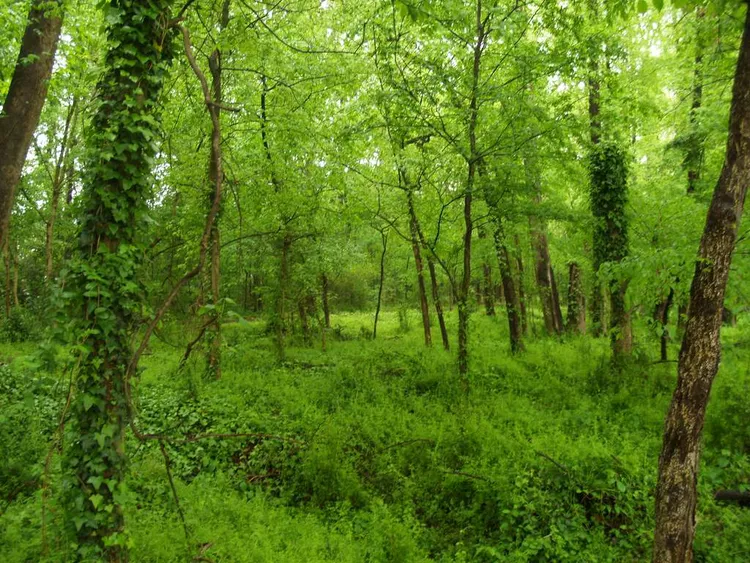Summary

While the term “swamp” is frequently associated with Congaree, this relatively new national park actually represents a floodplain forest. It inundates approximately ten times annually, rejuvenating an already vibrant ecosystem.
Established in 2003, this verdant area located in Central South Carolina is the largest continuous tract of old-growth bottomland hardwoods in the United States, extending northeast over 22,000 acres from the Congaree River. It creates a miniature world of its own, where hiking through moss-covered woods provides encounters with wild boars and bobcats. The sounds of industrious woodpeckers resonate throughout while playful river otters swim in the nearby waters. For those seeking authentic encounters with nature, Congaree serves as an exceptional starting point.
History
The territory was originally inhabited by the Congaree Indians, who tragically perished due to a smallpox outbreak that accompanied European settlement around 1700. Efforts were made until 1860 to cultivate and graze the land; however, the swamp-like conditions made this endeavor quite challenging.
By 1905, the Santee River Cypress Lumber Company, established by Francis Beidler, acquired a significant portion of the land. Logging operations encountered difficulties due to poor land accessibility, and activities ceased within a decade, leaving the floodplain largely untouched.
On October 18, 1976, the land received authorization as a National Monument, was designated as wilderness on October 24, 1988, and became a recognized Biosphere Reserve in 1983. Congaree ultimately attained the status of a National Park on November 10, 2003, thereby solidifying its importance.
When to Visit
The park remains accessible throughout the year; nonetheless, spring and fall are considered the most enjoyable times to visit. During these seasons, the landscape is especially lush and vibrant, complemented by ranger-led hikes that allow visitors to hear the calls of barred owls.
Moreover, boaters often prefer late winter and early spring for their visits, as paddling becomes more manageable following rainfall during these periods after precipitation.
Getting There
Travelers from Columbia, South Carolina, should head southeast on I-77 for 20 miles to exit 5, Bluff Road/S.C. 48. From there, follow the signage directing you to Congaree National Park, located at 100 National Park Road, Hopkins, South Carolina.
Fees and Permits
Entry to Congaree National Park is free of charge.
Major Attractions
The primary attractions of this national park reside along some of South Carolina’s most picturesque trails. The following trails encapsulate all that Congaree has to offer:
Boardwalk Trail: Spanning 2.4 miles, this trail showcases some of the tallest trees in the nation. Observe the following:
- Loblolly pines soaring over 160 feet high, some exceeding the height of the Amazon rainforest.
- Magnificent old bald cypress trees, with some measuring over 25 feet in circumference.
- Dead trees providing excellent habitats for fungi, birds, reptiles, and insects.
- Thick vines of muscadine grapes and climbing hydrangeas embracing the trunks of ancient trees, evoking a primordial atmosphere.
- Weston Lake: A playful setting for river otters alongside red-bellied turtles. This small oxbow lake, once part of the Congaree River, is now a distinct 25-foot deep body of water.
Weston Lake Loop Trail: This trail extends the Boardwalk Trail, covering 4.4 miles. It encompasses the largest sections of the park’s creeks, offering the best opportunities to observe herons and otters.
Oak Ridge Trail: Branching off from the Weston Lake Loop Trail, this trail necessitates a longer commitment. Allocate half to a full day for this 6.6-mile round-trip.
King-Snake Trail: An excellent choice for wildlife observation, this lightly trafficked trail allows for a secluded exploration of the park, presenting numerous bird species.
Cedar Creek Canoe Trail: Canoes can be rented, or visitors can inquire about the monthly guided tours through these dark, mysterious waters.
Accommodations
Within the park, there are two primitive campgrounds, and backcountry camping is permitted with required permits at no charge. Camping is available year-round with a limit of 14 days. For backcountry campers, it is essential to maintain at least 100 feet distance from roads, trails, lakes, and flowing water. Additionally, open fires are prohibited.
For visitors preferring accommodations outside the park, Columbia offers a variety of hotels, motels, and inns. The Econo Lodge on Fort Jackson Blvd. and the Holiday Inn on Gervais St. provide some of the most affordable options. Additionally, Claussen’s Inn is a commendable alternative.
Areas of Interest Outside the Park
Santee National Wildlife Refuge: Located just 50 miles southeast of Congaree National Park, this refuge serves as a sanctuary for nesting and migratory birds. Over 300 species have been observed, including the bald eagle, peregrine falcon, and wood stork. Visitors may also encounter alligators, deer, bobcats, turkeys, and coyotes. While camping is not allowed, activities such as fishing, scenic drives, and hiking are available.





